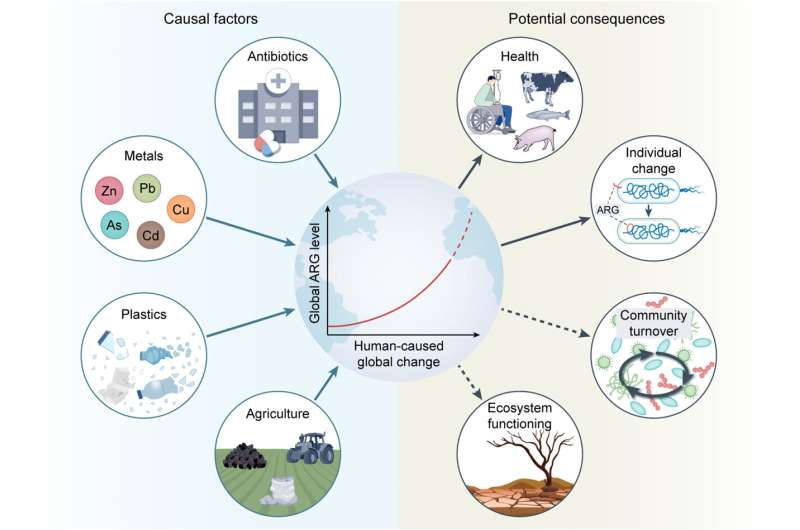This article has been reviewed according to Science X's editorial process and policies. Editors have highlighted the following attributes while ensuring the content's credibility:
fact-checked
peer-reviewed publication
trusted source
proofread
Elevated levels of antibiotic resistance genes should be considered a new factor of global change, researchers say

Human-caused global change is a complex phenomenon comprising many factors such as climate change, environmental contamination with chemicals, microplastics, light pollution, and invasive plants. One of the main tasks of global change biology is to investigate the effects of these factors, as well as to identify potential new ones.
The Rillig Lab at Freie Universität Berlin, led by biology professor Matthias Rillig, has been investigating factors of global change such as microplastics. In a new study, titled "Elevated Levels of Antibiotic Resistance Genes as a Factor of Human-Caused Global Environmental Change" published in the journal Global Change Biology, Rillig and his colleagues propose recognizing increased levels of antibiotic resistance genes (ARGs) in the environment as a new, standalone factor of global change.
Antibiotic resistance is a serious problem facing human health, with the environmental reservoirs of genes that provide this type of resistance an established topic of investigation for researchers around the world.
"These resistance genes do occur naturally, for example, in the soil. However, our proposal is related to how their number is increasing as a result of human activity," says Rillig. In part, this resistance is due to antibiotics that make their way into the environment through improper disposal and their increased use in human and veterinary medicine.
However, these are not the only reasons. It has been shown that many factors of global change also contribute toward raising antibiotic resistance. For example, pollution with heavy metals or microplastics has also been shown to elevate levels of ARGs.
"Faced with the number of global change factors that increase antibiotic resistance in the environment, the global spread of these effects, and the fact that these genes have very real biological consequences, we need to consider the increased number of ARGs itself a factor of global change," says Rillig, first author of the study. In the paper, the researchers argue that ARGs meet all the necessary criteria to be defined as a factor of global change.
Including ARGs in the list of factors of global change would bring with it an important change in perspective. Previously, these genes were primarily considered measurement variables, i.e., the research focus was on if and how various human-caused factors influence these genes. Now, however, the ARGs themselves can be a treatment factor in experiments, i.e., a variable that can be directly manipulated in the lab.
"This means we can uncover the effects these genes have on ecosystem processes or biodiversity—for example, when we add them as part of a controlled experiment—as well as investigate how they interact with other important factors of global change," explains Rillig.
This would require some innovations to be made in terms of experimental design, but Rillig and his team are already at work planning the first experiments.
More information: Matthias C. Rillig et al, Elevated levels of antibiotic resistance genes as a factor of human‐caused global environmental change, Global Change Biology (2024). DOI: 10.1111/gcb.17419
Journal information: Global Change Biology
Provided by Freie Universitaet Berlin


















